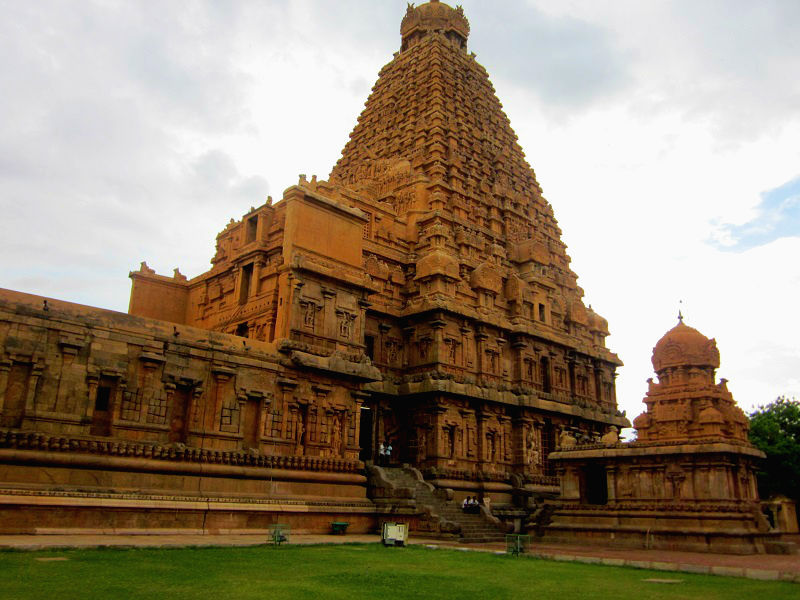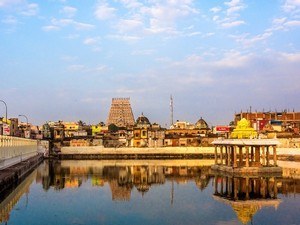Brihadeeswarar Temple, Thanjavur - Timings, History, Architecture, Best Time to Visit
Photo Credit: Flickr
 #1 of 31 Places to Visit in Thanjavur
#1 of 31 Places to Visit in Thanjavur
 Distance (From Thanjavur Junction Railway Station): 2 Kms
Distance (From Thanjavur Junction Railway Station): 2 Kms
 Trip Duration (Including Travel): 2 Hours
Trip Duration (Including Travel): 2 Hours
 Transportation Options: Cab / Auto
Transportation Options: Cab / Auto
 Travel Tips: None
Travel Tips: None
About Brihadeeswarar Temple
At a distance of 2 km from Thanjavur Junction Railway Station, the Brihadeeswarar Temple is an ancient Hindu temple located on the banks of the Kaveri River in Thanjavur, Tamil Nadu. Also known as Peruvudaiyar Kovil or Periya Kovil, it is one of the famous heritage places to visit in Tamilnadu, and among the must include places in Thanjavur tour packages. Also known as The Big Temple, Brihadeeswarar Temple is dedicated to Lord Shiva and is famous for its grandeur and beautiful sculptures.
It is one of the largest Hindu temples in India, and an exemplar of Tamil architecture. It is also called Dakshina Meru (Meru of the South). The temple is a part of the UNESCO World Heritage Site known as the 'Great Living Chola Temples', along with the Gangaikonda Cholapuram Temple and Airavatesvara Temple. It is one of the most visited heritage sites in Tamil Nadu.
History of Brihadeeswarar Temple
The Brihadeeswara Temple in Thanjavur was constructed by the Chola emperor Rajaraja I between the years 1003 and 1010 CE, and was named Rajarajeswaram by the king. This temple was the first of many significant architectural endeavors undertaken by the Tamil Chola dynasty. According to epigraphical records, Rajaraja I initiated the construction of this temple in his 19th year and completed it on the 275th day of his 25th year, resulting in a total construction period of just six years, concluding in 1010 AD. The main temple, along with its towering gopurams, dates back to the early 11th century. Over the course of the next millennium, the temple underwent numerous additions, renovations, and repairs. It suffered damage due to raids and conflicts, particularly between the Muslim Sultans of Madurai and the Hindu rulers of Thanjavur, but these damages were subsequently repaired by the Hindu dynasties that regained control. Notable shrines dedicated to Kartikeya, Parvati, and Nandi were constructed during the Nayaka period in the 16th and 17th centuries, while the Dakshinamurti shrine was added later. The temple was also well-preserved by the Marathas of Thanjavur.
Architecture of Thanjavur Temple
Also known as Peruvudaiyar Kovil, the Brihadeeswarar Temple is a brilliant example of the major heights achieved by Cholas in temple architecture. The entire temple structure is made out of hard sandstone hardly available in the Thanjavur area where the temple is located. The rectangular temple complex consists of an entrance tower followed by the main temple complex spread on a plot of 33,000 sq. ft. The main temple was built on a raised mound aligning to the principles of geometry and symmetry. The inner part of the temple starts with a large Nandi mandapa that houses a 12-foot tall monolithic idol of Nandi.
The main shrine of Brihadeeswarar boasts an amazing structure with a large mandapa followed by an antarala and the sanctum. The main entrance is facing east and there are two exits from antarala towards north and south. The 13-tier tower over the sanctum is the prime attraction of the temple which is 216 feet in height built in Dravidian style. At the top of vimana sits Sikhara in the shape of a cupola carved out of a monolithic granite stone that weighs 80 tons. It is said that a 2 km long ramp was built to carry the Sikhara and place it on the peak. The shadow of Sikhara never falls on the ground. The innermost chamber called Karuvarai or womb chamber houses the Shiv Linga and only priests are allowed to enter this area of Brihadeshwara Temple.
The inner walls of the temple are surrounded by large corridors providing shelter to several small shrines. The outer wall of the upper story is carved with 108 dance postures of Bharathanatyam, the classical dance of Tamil Nadu. There complex also houses the shrines of Brihan Nayaki temple (built by Pandyas), Subrahmanya Temple (Vijayanagara period), Vinayaka Temple (by Maratha rulers). Unlike other Hindu temples, the temple tower at the entrance is considerably smaller than the vimana over the sanctum.
Festivals of Brihadeeswarar Temple
The principal festivals observed at Brihadeeswarar Temple encompass Maha Shivaratri, Panguni Uthiram, Aani Thirumanjanam, and Arudra Darshanam. The Maha Shivaratri festival, occurring in February or March, attracts a significant number of pilgrims and tourists, offering a distinctive perspective on the temple's ritualistic practices. This magnificent UNESCO World Heritage Site, the grand Brihadeeshwara Temple, also hosts an International Indian Classical Dance Festival, where classical dancers from around the globe gather annually to honor the Cosmic Dancer, Lord Shiva, on the eve of Mahashivaratri.
Thanjavur Temple Dress Code & Other Restrictions
There is no specific dress code but it is suggested to dress up modestly and avoid modern clothes like mini-skirts, low-waist jeans, shorts, and even sleeveless tops while visiting the temple premises.
Non-Hindus are allowed to visit the temple complex and admire the architecture but may not be permitted inside the sanctum sanctorum.
Thanjavur Temple Timings
Monday: 6 AM - 12:30 & 4 PM - 8:30 PM
Tuesday: 6 AM - 12:30 & 4 PM - 8:30 PM
Wednesday: 6 AM - 12:30 & 4 PM - 8:30 PM
Thursday: 6 AM - 12:30 & 4 PM - 8:30 PM
Friday: 6 AM - 12:30 & 4 PM - 8:30 PM
Saturday: 6 AM - 12:30 & 4 PM - 8:30 PM
Thanjavur Temple Entry Fee
General Entry is Free
Special Darshan is available on Sundays for Rs. 5
Best Time to Visit Thanjavur Temple
The best time to visit the Brihadeeswarar Temple is during the winter months from October to March, when the weather pleasant and more suitable for sightseeing. Additionally, the temple organizes a variety of festivals throughout the year, with the Maha Shivarathri festival standing out as one of the most significant occasions for a visit.
How to Reach Brihadeeswarar Temple
The Brihadeeswarar Temple is situated merely 2 kilometers from the Thanjavur Railway Station and 5 kilometers from the Thanjavur Bus Stand. Visitors can utilize bus services, hire a car, or take an auto-rickshaw to access the temple from these locations. Thanjavur is efficiently connected to various cities in Tamil Nadu through both road and rail networks. Although Thanjavur does not possess an airport, the nearest airport is located in Tiruchirapalli, which offers flights to both domestic and international destinations. Travelers arriving at Tiruchirapalli can opt for a taxi or a bus to reach Thanjavur.














